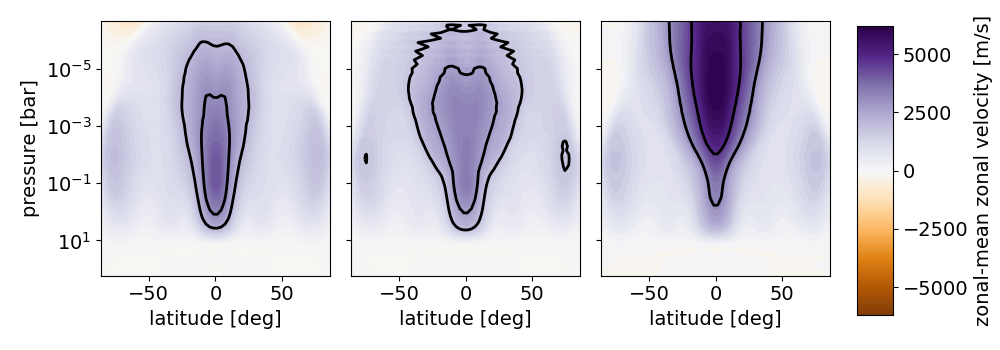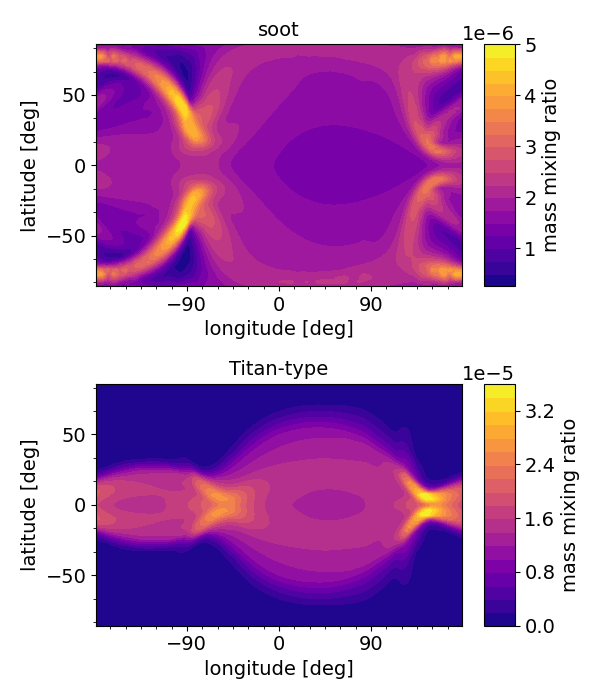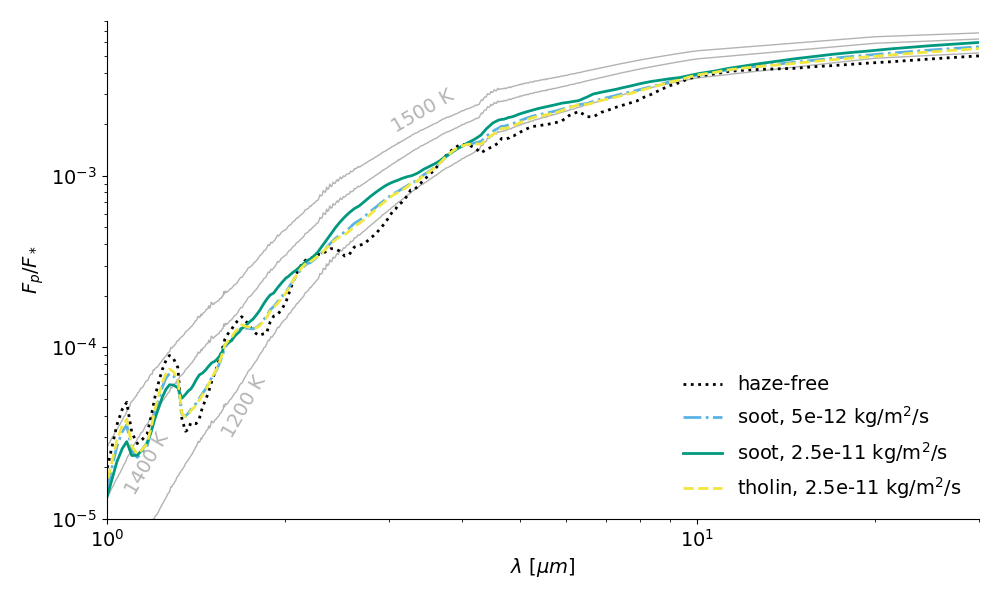Photochemical hazes dramatically alter temperature structure and atmospheric circulation in 3D simulations of hot Jupiters
- 1Max Planck Institute for Astronomy, Heidelberg, Germany
- 2Lunar and Planetary Laboratory, University of Arizona, Tucson, United States of America
- 3Atmospheric, Ocean, and Planetary Physics, Department of Physics, Oxford University, United Kingdom
- 4Groupe de Spectrométrie Moléculaire et Atmosphérique, UMR CNRS 7331, Université de Reims Champagne-Ardenne, Reims, France
- 5Department of Earth and Planetary Sciences, University of California, Santa Cruz, United States of America
Motivation
Photochemical hazes are expected to form in the atmospheres of many hot Jupiters, especially those with equilibrium temperatures near 1,200 K (like HD 189733b) and below. Heating and cooling from photochemical hazes can strongly impact temperature structure and atmospheric circulation but has previously been neglected in 3D general circulation models (GCMs) of hot Jupiters.
Methods
We present 3D simulations of hot Jupiter HD 189733b that include radiative feedback from photochemical hazes. Hazes were simulated as radiatively active tracers with a constant particle size of 3 nm. For the nominal simulations, a complex refractive index of soot was assumed. To examine how the results depend on the choice of the refractive index, we also performed additional simulations with a refractive index of Titan-type hazes.
Effect on atmospheric circulation
The response of atmospheric circulation to heating and cooling by hazes strongly depends on the assumed haze refractive index. For simulations with soot-like hazes, the equatorial jet broadens and slows down (Fig. 1, center panel). At low pressures, the day-to-night component of the flow strengthens. Vertical velocities increase. The horizontal haze mixing ratio distribution (Fig. 2) remains relatively similar to simulations without haze radiative feedback, with particularly high haze abundances near the morning terminator (as also seen in Steinrueck et al., 2021). For simulations with Titan-type hazes, the equatorial jet instead accelerates and extends to lower pressures (Fig. 1, right panel). This results in a substantially different 3D distribution of hazes, with hazes being most abundant at the dayside, the evening terminator and the equatorial region around the planet. This means that circulation, thermal structure, and haze distribution depend strongly on the assumed haze composition and optical properties.

Fig. 1: Zonal-mean zonal velocity in a simulation without haze radiative feedback (left), with soot-like hazes (center) and with Titan-type hazes (right). Black contours highlight the regions in which the zonal-mean zonal velocity is larger than 50% and 75% of its peak value within the simulation. The haze production rates are identical for both simulations with haze radiative feedback (2.5x10-11 kg/m2/s).

Fig. 2.: Haze mass mixing ratio at the 0.1 mbar level in a simulation with soot-like hazes (left) and with Titan-type hazes (right). The substellar point is located at the center of each panel. Both simulations shown have a haze production rate of 2.5x10-11 kg/m2/s at the substellar point.
Effect on temperature structure and emission spectra
In all simulations with haze radiative feedback, strong thermal inversions appear at low pressures on the dayside (Fig. 3). In the soot-like case, two distinct thermal inversions form, separated by a temperature minimum below the haze production region. This additional structure is not seen in 1D simulations. It is caused by upwelling on the dayside transporting air with low haze abundance upwards, resulting in a local minimum in the haze number density below the production region. Deeper regions of the atmosphere (p>100 mbar) cool compared to simulations without hazes.
The altered temperature structure leads to changes in emission spectra (Fig. 4): The amplitude of the near-infrared water features decreases in simulations with haze radiative feedback. At wavelengths > 4 µm, the emitted flux increases. Because thermal inversions caused by photochemical hazes peak at much lower pressures than the regions probed by existing low-resolution observations, current observations of HD 189733b neither confirm nor rule out such a temperature inversion.
Fig. 3: Dayside temperature profiles, calculated using an average weighted by the cosine of the angle of incidence

Fig. 4: Dayside emission spectra. For comparison, blackbody spectra are shown as thin gray lines.
References:
Steinrueck, M. E., A. P. Showman, P. Lavvas, T. Koskinen, X. Tan, and X. Zhang (2021). MNRAS, 504(2), pp. 2783-2799. doi:10.1093/mnras/stab1053.
How to cite: Steinrueck, M., Koskinen, T., Parmentier, V., Lavvas, P., Tan, X., and Zhang, X.: Photochemical hazes dramatically alter temperature structure and atmospheric circulation in 3D simulations of hot Jupiters, Europlanet Science Congress 2022, Granada, Spain, 18–23 Sep 2022, EPSC2022-763, https://doi.org/10.5194/epsc2022-763, 2022.

